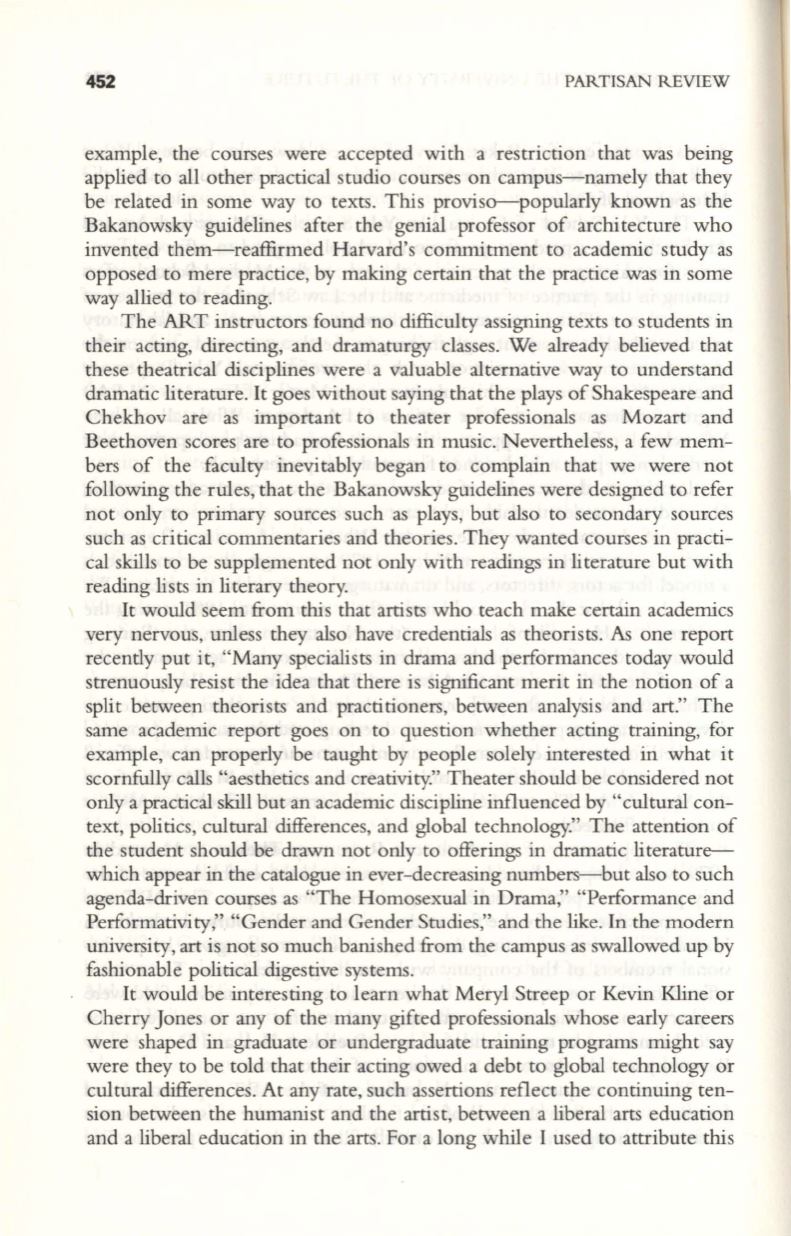
452
PARTISAN REVIEW
example, the courses were accepted with a restnctlOn that was being
applied to all other practical studio courses on campus-namely that they
be related in some way to texts. This proviso-popularly known as the
Bakanowsky guidelines after the genial professor of architecture who
invented them-reaffirmed Harvard's commitment to academic study as
opposed to mere practice, by making certain that the practice was in some
way allied to reading.
The ART instructors found no difficulty assigning texts to students in
their acting, directing, and dramaturgy classes. We already believed that
these theatrical disciplines were a valuable alternative way to understand
dramatic literature.
It
goes without saying that the plays of Shakespeare and
Chekhov are as important to theater professionals as Mozart and
Beethoven scores are to professionals in music. Nevertheless, a few mem–
bers of the faculty inevitably began to complain that we were not
following the rules, that the Bakanowsky guidelines were designed to refer
not only to primary sources such as plays, but also to secondary sources
such as critical commentaries and theories. They wanted courses in practi–
cal skills to be supplemented not only with readings in literature but with
reading lists in literary theory.
It
would seem from this that artists who teach make certain academics
very nervous, unless they also have credentials as theorists. As one report
recently put it, "Many specialists in drama and performances today would
strenuously resist the idea that there is significant merit in the notion of a
split between theorists and practitioners, between analysis and art." The
same academic report goes on to question whether acting training, for
example, can properly be taught by people solely interested in what it
scornfully calls "aesthetics and creativity." Theater should be considered not
only a practical skill but an academic discipline influenced by "cultural con–
text, politics, cultural differences, and global technology." The attention of
the student should be drawn not only to offerings in dramatic literature-–
which appear
in
the catalogue in ever-decreasing numbers-but also to such
agenda-driven courses as "The Homosexual in Drama," "Performance and
Performativity," "Gender and Gender Studies," and the like.
In
the modern
university,
art
is not so much banished from the campus as swallowed up by
fashionable political digestive systems.
It
would be interesting to learn what Meryl Streep or Kevin Kline or
Cherry Jones or any of the many gifted professionals whose early careers
were shaped in graduate or undergraduate training programs might say
were they to be told that their acting owed a debt to global technology or
cultural differences. At any rate, such assertions reflect the continuing ten–
sion between the humanist and the artist, between a liberal arts education
and a liberal education in the arts. For a long while I used to attribute this


